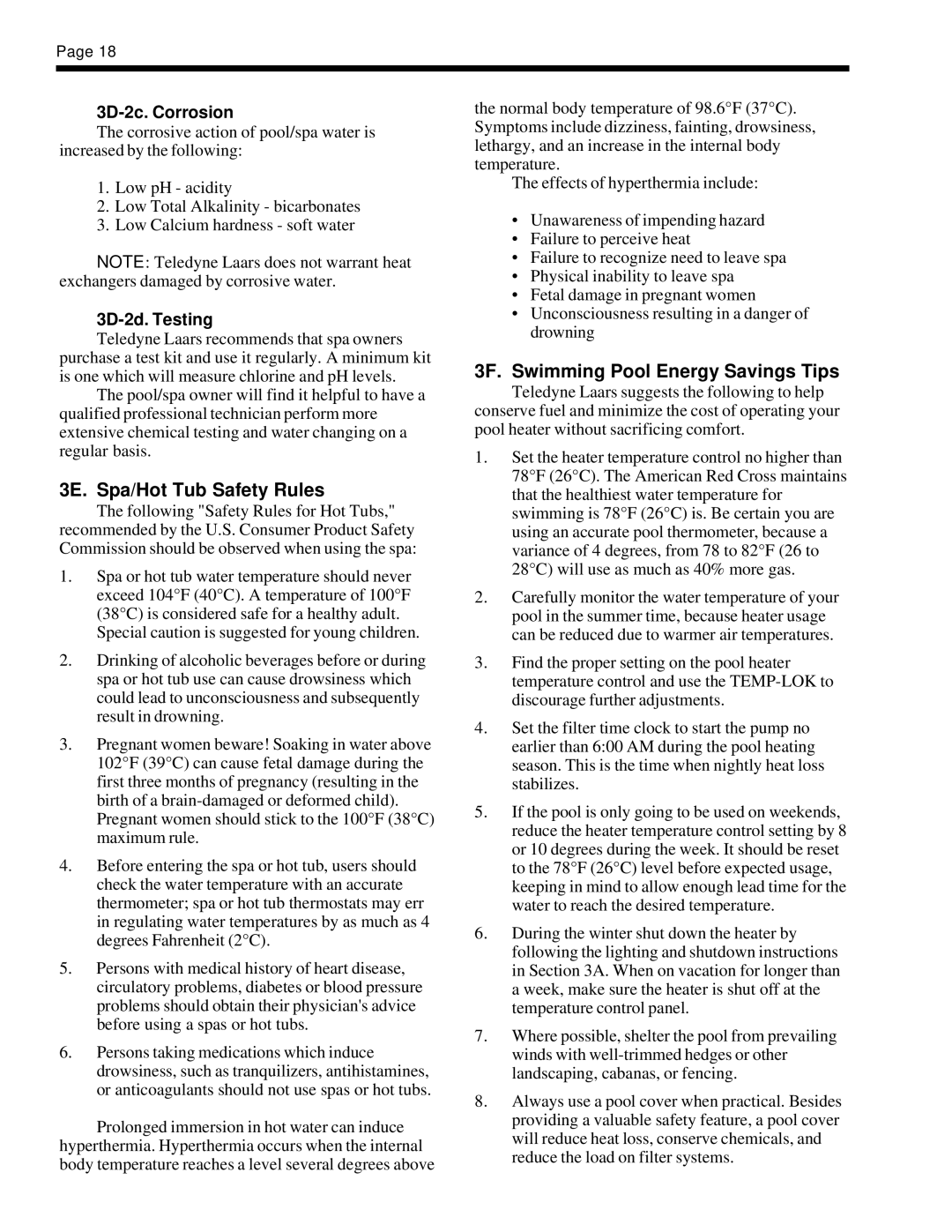Page 18
3D-2c. Corrosion
The corrosive action of pool/spa water is increased by the following:
1.Low pH - acidity
2.Low Total Alkalinity - bicarbonates
3.Low Calcium hardness - soft water
NOTE: Teledyne Laars does not warrant heat exchangers damaged by corrosive water.
3D-2d. Testing
Teledyne Laars recommends that spa owners purchase a test kit and use it regularly. A minimum kit is one which will measure chlorine and pH levels.
The pool/spa owner will find it helpful to have a qualified professional technician perform more extensive chemical testing and water changing on a regular basis.
3E. Spa/Hot Tub Safety Rules
The following "Safety Rules for Hot Tubs," recommended by the U.S. Consumer Product Safety Commission should be observed when using the spa:
1.Spa or hot tub water temperature should never exceed 104°F (40°C). A temperature of 100°F (38°C) is considered safe for a healthy adult.
Special caution is suggested for young children.
2.Drinking of alcoholic beverages before or during spa or hot tub use can cause drowsiness which could lead to unconsciousness and subsequently result in drowning.
3.Pregnant women beware! Soaking in water above 102°F (39°C) can cause fetal damage during the first three months of pregnancy (resulting in the birth of a
4.Before entering the spa or hot tub, users should check the water temperature with an accurate thermometer; spa or hot tub thermostats may err in regulating water temperatures by as much as 4 degrees Fahrenheit (2°C).
5.Persons with medical history of heart disease, circulatory problems, diabetes or blood pressure problems should obtain their physician's advice before using a spas or hot tubs.
6.Persons taking medications which induce drowsiness, such as tranquilizers, antihistamines, or anticoagulants should not use spas or hot tubs.
Prolonged immersion in hot water can induce hyperthermia. Hyperthermia occurs when the internal body temperature reaches a level several degrees above
the normal body temperature of 98.6°F (37°C). Symptoms include dizziness, fainting, drowsiness, lethargy, and an increase in the internal body temperature.
The effects of hyperthermia include:
•Unawareness of impending hazard
•Failure to perceive heat
•Failure to recognize need to leave spa
•Physical inability to leave spa
•Fetal damage in pregnant women
•Unconsciousness resulting in a danger of drowning
3F. Swimming Pool Energy Savings Tips
Teledyne Laars suggests the following to help conserve fuel and minimize the cost of operating your pool heater without sacrificing comfort.
1.Set the heater temperature control no higher than 78°F (26°C). The American Red Cross maintains that the healthiest water temperature for swimming is 78°F (26°C) is. Be certain you are using an accurate pool thermometer, because a variance of 4 degrees, from 78 to 82°F (26 to 28°C) will use as much as 40% more gas.
2.Carefully monitor the water temperature of your pool in the summer time, because heater usage can be reduced due to warmer air temperatures.
3.Find the proper setting on the pool heater temperature control and use the
4.Set the filter time clock to start the pump no earlier than 6:00 AM during the pool heating season. This is the time when nightly heat loss stabilizes.
5.If the pool is only going to be used on weekends, reduce the heater temperature control setting by 8 or 10 degrees during the week. It should be reset to the 78°F (26°C) level before expected usage, keeping in mind to allow enough lead time for the water to reach the desired temperature.
6.During the winter shut down the heater by following the lighting and shutdown instructions in Section 3A. When on vacation for longer than a week, make sure the heater is shut off at the temperature control panel.
7.Where possible, shelter the pool from prevailing winds with
8.Always use a pool cover when practical. Besides providing a valuable safety feature, a pool cover will reduce heat loss, conserve chemicals, and reduce the load on filter systems.
